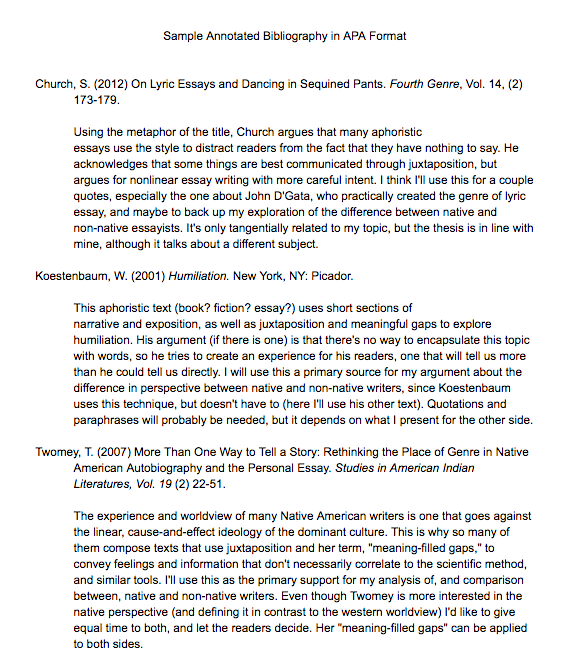A bibliography is a list of sources that provides data related to earch source including the author's name, the title, publication information, and page numbers referenced. An annotated bibliography is also a list of sources that provides related data, but it also contains brief notes about each source.
Annotated bibliographies enable writers to organize key information about sources. They make the drafting and revising processes easier, because data can be easily accessed. Writers can refer to their annotated bibliographies while drafting to find the information they need to create in-text or parenthetical citations. By means of a bibliography, writers let readers know what they found during the research process and where they found it. Annotated bibliographies help writers remember why, and in what way, sources are relevant to their argument, and how to use those sources in their essays.
When responding to a source, there are several steps that writers should take to create (and eventually use) an annotated bibliography.
Bibliographic data includes the following:
Annotated bibliographies require writers to provide certain information for each source. Bibliographic data must be formatted according to the required style (.e.g., the Modern Language Association — MLA; or the American Psychological Association — APA). The example in the next section was formatted according to the APA Style Guide..
Bibliographic data is followed by a brief paragraph about the source. There are no requirements for what these notes should include, or how extensive they should be. Writers must decide what works best for each entry in the bibliography. A sentence or two that restates and summarizes (in the writer's own words) the thesis and main ideas of the source, and one or two sentences that indicate how the source could be used to support the essay, is usually sufficient.
When each annotated entry is complete, it should be inserted in the bibliography in alphabetical order, according to the style guidelines that are being used.
The following example includes three sources and the annotations that were used before writing an essay. The sources are listed alphabetically, according to the author's last names.

Note the bibliographic information that corresponds to the first annotation. It includes the writer's name and first initial, followed by the publication date. The APA style guidelines prioritize date over most other information. Next comes the title of the essay, "On Lyric Essays and Dancing in Sequined Pants," followed by the name of the literary journal in which it was published (in italics): Fourth Genre, Vol. 14, the second issue, and the pages it references. Below that is the paragraph that comprises the annotation of the source. It includes basic information about the article and a short explanation of why the writer thinks it will be useful.
The bibliographic information for the second source is similar. It includes the author's last name, first initial, and the date of publication. However, since this source is a book, it only lists the title, Humiliation, and the publishing information. Read the writer's annotation. Note that it includes a short summary of the source and a brief discussion of how the writer thinks it may be useful. Also note the reference to the other texts he or she intends to use.
The bibliographic presentation for the last source is the same as the first source. It lists the author's last name, followed by the publication date and the title of the article, "More Than One Way to Tell a Story, Rethinking the Place of Genre in Native American Autobiography and the Personal Essay." It includes the journal in which it was published, Studies in American Indian Literatures, Vol. 19, the second issue, and the pages on which it appears. The annotation includes a short summary of the article, consisting of its thesis and how the writer plans to use it to support his or her analysis.
Annotated bibliographies don't have to be long or complicated to be useful for writers during the drafting process.
Source: Adapted from Sophia Instructor Gavin McCall